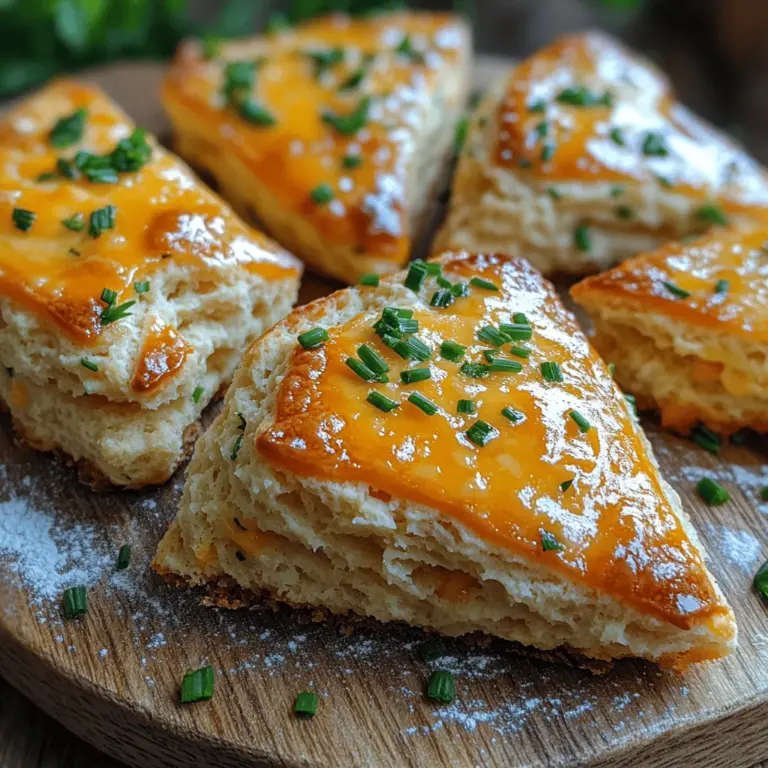Scones are more than just a delightful baked treat; they are a canvas for culinary creativity that can elevate any meal or snack time. Whether enjoyed during a leisurely brunch, paired with a comforting bowl of soup, or served as an elegant addition to a tea party, scones have a unique way of bringing warmth and joy to the table. Among the myriad of flavors and variations, Herbed Cheddar Bliss Scones stand out with their savory twist. This recipe combines the richness of sharp cheddar cheese with the fragrant freshness of herbs, resulting in a scone that is both comforting and sophisticated.
The beauty of Herbed Cheddar Bliss Scones lies in their versatility. They can be enjoyed fresh from the oven, served warm with a pat of butter, or even used as a base for sandwiches. This article will guide you through the process of making these delectable scones, exploring their unique flavor profile, nutritional benefits, and occasions where they shine. With a few simple ingredients and straightforward steps, you’ll be able to impress family and friends with your baking prowess. Whether you’re an experienced baker or a novice in the kitchen, these scones are sure to become a favorite recipe in your collection.
Understanding the Ingredients: A Closer Look at What Makes These Scones Special
Before diving into the step-by-step preparation of Herbed Cheddar Bliss Scones, it’s essential to understand the key ingredients that contribute to their delicious flavor and texture. Each component plays a vital role in creating the perfect scone, ensuring that they are flaky, flavorful, and utterly irresistible.
Exploring the Base Ingredients
– All-Purpose Flour: The foundation of the scone, all-purpose flour provides the necessary structure and body. Its moderate protein content helps achieve a tender crumb while still allowing for a bit of chewiness, which is desirable in scones.
– Baking Powder and Baking Soda: These key leavening agents are crucial for achieving the light and airy texture characteristic of a perfect scone. Baking powder provides immediate lift, while baking soda works in conjunction with acidic components in the recipe to ensure a proper rise.
– Unsalted Butter: Contributing to the flakiness and richness of the scones, cold unsalted butter is essential. When incorporated into the dry ingredients, it creates small pockets of fat that result in a tender and flaky texture.
The Star Ingredients: Cheese and Herbs
– Sharp Cheddar Cheese: The star of this scone recipe, sharp cheddar cheese adds a robust flavor and creamy texture. Its bold taste complements the herbs beautifully, creating a savory experience with every bite.
– Fresh Chives and Parsley: These herbs bring brightness and a burst of color to the scones. Chives add a mild onion flavor, while parsley provides a refreshing herbal note, elevating the overall taste profile.
– Garlic Powder: While not overpowering, garlic powder elevates the flavor profile with a subtle aromatic touch, enhancing the savory aspect of the scones without overwhelming the other ingredients.
With a clear understanding of the ingredients, you’re now ready to embark on the journey of crafting Herbed Cheddar Bliss Scones. The next section will outline the essential tools and equipment you’ll need, as well as the importance of using cold ingredients for optimal scone-making results.
Step-by-Step Preparation: Crafting the Perfect Scone
Creating the perfect Herbed Cheddar Bliss Scones begins with proper kitchen preparation. Ensuring that you have all the necessary tools and ingredients ready will streamline the baking process and set you up for success.
Prepping Your Kitchen
Essential Tools and Equipment Needed for Scone-Making:
– Mixing bowls: A large bowl for combining dry ingredients and a medium bowl for wet ingredients.
– Pastry cutter or two forks: For cutting in the butter.
– Baking sheet: A flat surface for baking your scones.
– Parchment paper: Optional, but recommended for easy cleanup and to prevent sticking.
– Measuring cups and spoons: Accurate measurements are crucial for consistent results.
– Rolling pin: While not always necessary, it can help shape the scones if you choose to roll out the dough.
Importance of Using Cold Ingredients for the Perfect Scone Texture:
Using cold ingredients, particularly the butter, is vital for achieving the desired flaky texture in scones. Cold butter melts as the scones bake, creating steam that leavens the dough and forms those coveted flaky layers. Make sure to keep your butter refrigerated until you’re ready to use it, and consider chilling your mixing bowl if your kitchen tends to be warm.
Mixing the Dry Ingredients
The first step in the scone-making process is to mix the dry ingredients. This step is crucial for achieving the right consistency in your flour mixture.
How to Achieve the Right Consistency in Your Flour Mixture:
1. In a large mixing bowl, sift together the all-purpose flour, baking powder, baking soda, garlic powder, and a pinch of salt. Sifting helps to aerate the flour and evenly distribute the leavening agents, ensuring a consistent rise.
2. Use a whisk or fork to thoroughly combine the dry ingredients. A well-mixed dry mixture is essential for the scones to rise evenly during baking.
Incorporating the Butter
Once your dry ingredients are well combined, it’s time to incorporate the butter, a critical step in achieving the perfect scone texture.
Techniques for Cutting in Butter: Achieving the Right Crumb Texture:
1. Cut the cold unsalted butter into small cubes (about 1/2-inch pieces) to ensure even distribution throughout the flour mixture.
2. Using a pastry cutter or two forks, cut the butter into the flour mixture until the texture resembles coarse crumbs. Be careful not to overwork the dough; you want to leave some small bits of butter visible for that coveted flakiness.
The Role of Cold Butter in Creating Flaky Layers:
As mentioned earlier, cold butter is key to creating flaky layers in your scones. The small pieces of butter left intact in the dough will melt during baking, creating steam that lifts the dough and results in light, airy scones.
Adding Flavorful Elements
Now that your dry ingredients and butter are combined, it’s time to introduce the flavorful elements that will elevate your Herbed Cheddar Bliss Scones.
Tips for Evenly Distributing Cheese and Herbs Throughout the Dough:
1. Gently fold in the sharp cheddar cheese, fresh chives, and parsley into the flour mixture. Use a spatula or wooden spoon to ensure even distribution without overmixing the dough.
2. If you prefer a stronger cheese flavor, consider adding a bit more cheddar or experimenting with different types of cheese for a unique twist.
Adjusting Flavors: How to Customize the Scone to Your Taste:
Feel free to experiment with different herbs or spices to personalize your scones. For instance, thyme or rosemary could add a delightful twist, or you might want to incorporate a bit of red pepper flakes for a touch of heat.
Combining Wet and Dry Ingredients
The final step in preparing the dough for your Herbed Cheddar Bliss Scones is to combine the wet and dry ingredients. This process is simple yet crucial for achieving the right texture.
1. In a separate medium bowl, combine your wet ingredients, typically including milk and an egg. Whisk them together until fully combined.
2. Create a well in the center of your dry mixture and pour in the wet ingredients. Gently stir until the dough just comes together. Avoid overmixing to prevent tough scones; the dough should be slightly shaggy and not overly smooth.
3. If the dough feels too dry, you can add a splash of milk to help moisten it. Conversely, if the dough seems too wet, sprinkle in a bit more flour until you reach the right consistency.
With your dough ready, you are now prepared to shape and bake your Herbed Cheddar Bliss Scones. The next part of this article will guide you through the final steps to achieve perfectly baked scones that are sure to delight. Stay tuned for expert tips on shaping, baking, and serving these savory delights that will impress your family and friends.
{{image_1}}
The Importance of Not Over-Mixing: Achieving That Perfect Scone Texture
When it comes to baking scones, one of the most crucial factors to consider is the mixing technique. Over-mixing can lead to tough and chewy scones rather than the light and flaky texture you desire. The key is to handle the dough as gently as possible. As you combine your dry ingredients with the wet ones, use a light touch. Mix until just combined, allowing some lumps to remain. This approach creates pockets of air within the dough, which expand during baking, resulting in the perfect scone structure.
The goal is to maintain the integrity of the butter pieces within the dough. When these pieces melt during baking, they create steam that helps lift the scones, contributing to their airy quality. Remember, less is more when it comes to mixing. Trust the process, and your scones will reward your patience with a delightful texture.
Signs of Readiness: Knowing When Your Dough is Just Right
Understanding the signs of readiness is essential to achieving the best results in your baking. Once you have mixed your ingredients, your dough should be slightly sticky but manageable. If it feels too wet, sprinkle a little extra flour; if it’s too dry, add a splash of milk. The ideal dough will hold together without crumbling or sticking excessively to your hands.
Another sign that your dough is ready is its elasticity. When you gently pull at the dough, it should stretch without breaking too easily. If it breaks apart, you may need to knead it lightly for a few more seconds, but remember to avoid overworking it. Once you achieve this balance, it’s time to move on to shaping the dough.
Shaping and Preparing for Baking
Techniques for Shaping the Dough: Options for Triangles vs. Circles
Shaping your scones is a fun part of the process and can impact the final presentation. There are two popular shaping techniques: triangles and circles.
1. Triangles: To shape your scones into triangles, start by gently patting the dough into a circle about 1 to 1.5 inches thick. Using a sharp knife or a bench scraper, cut the circle into wedges, like slicing a pizza. This method is traditional and allows for easy portioning.
2. Circles: For round scones, roll out your dough on a floured surface to about 1 inch thick, then use a biscuit cutter or a glass to cut out individual circles. Be sure to press straight down without twisting to ensure the scones rise evenly.
Regardless of the method you choose, ensure that the pieces are not crowded on the baking sheet. Leave enough space for them to expand while baking.
How to Achieve a Golden Crust with Egg Wash and Optional Toppings
For a beautiful golden crust, an egg wash is essential. To create an egg wash, whisk together one egg with a tablespoon of milk or water until smooth. Brush this mixture lightly over the tops of your shaped scones just before baking. This technique not only enhances the color but also adds a slight sheen that makes your scones visually appealing.
You can also experiment with toppings. For an extra layer of flavor, sprinkle grated cheese or herbs on top of the egg wash before baking. This adds a delightful crunch and enhances the herby notes of your Herbed Cheddar Bliss Scones.
Baking Your Scones: Achieving the Perfect Texture and Flavor
Understanding Oven Temperatures
Preheating your oven is a vital step that should not be overlooked. A properly preheated oven ensures that your scones begin baking immediately, which is crucial for achieving the desired rise and texture. The science behind preheating lies in the rapid expansion of gases when the dough is exposed to high heat. This creates that light and flaky structure we love in scones.
Set your oven to 400°F (200°C) and allow it to preheat fully before placing your scones inside. This temperature is ideal for scones, as it allows for a quick rise and helps develop a nice crust without over-baking the insides.
Ideal Baking Conditions for Achieving Golden-Brown Scones
Once your scones are in the oven, avoid opening the door frequently. Each time you do, the temperature drops, which can affect the baking process. Bake your scones for about 15-20 minutes, or until they are golden brown and have risen beautifully.
The ideal scone will have a lightly crisp exterior with a soft and tender interior. The edges should not be overly brown, and they should feel firm to the touch. If you notice that the tops are browning too quickly, you can loosely cover the scones with aluminum foil during the last few minutes of baking.
Monitoring Doneness
How to Check if Scones are Perfectly Baked
To determine if your scones are done, gently tap the sides with your finger. They should feel firm and not doughy. Another reliable method is to insert a toothpick into the center of one of the scones; if it comes out clean or with just a few crumbs attached, your scones are ready.
What to Look for in Color and Texture for the Best Results
The perfect scone should have a golden-brown hue on top, with a slightly paler bottom. The texture should be soft yet sturdy, and when you break one open, you should see visible layers indicating flakiness. If they still appear too pale after the recommended baking time, leave them in for an additional minute or two, keeping a close eye to prevent over-baking.
Serving Suggestions: Enjoying Your Herbed Cheddar Bliss Scones
Pairing with Spreads and Dips
Herbed Cheddar Bliss Scones are incredibly versatile and can be enjoyed in various ways. For a classic approach, serve them warm with a pat of butter or a smear of cream cheese. The richness of butter complements the sharpness of the cheddar beautifully.
For a savory twist, consider serving your scones with a spread made from herbs, garlic, or even a savory cream cheese dip. These toppings enhance the flavors of the scones and create a delightful tasting experience.
Creative Serving Ideas: Transforming Scones into a Sandwich or Appetizer
Another creative serving idea is to cut your scones in half and fill them with your favorite ingredients. Think of them as a base for a breakfast sandwich with scrambled eggs and avocado or as a vessel for a savory filling like sliced turkey and cheese. They can also serve as an appetizer when paired with a flavorful dip, making them perfect for parties or gatherings.
Occasions for Herbed Cheddar Bliss Scones
Ideal Settings for Serving: Breakfast, Brunch, or as a Side Dish
Herbed Cheddar Bliss Scones can elevate any meal setting. They make a fantastic addition to breakfast or brunch, whether served alongside a fresh fruit salad or a hearty soup. Their savory profile also allows them to shine as a side dish at dinner, complementing meals like grilled chicken or roasted vegetables.
How These Scones Can Elevate Festive Gatherings and Casual Get-Togethers
These scones are perfect for festive occasions, too. Whether it’s a holiday gathering, a baby shower, or a casual get-together with friends, serving Herbed Cheddar Bliss Scones will impress your guests. Their enticing aroma and delightful taste will have everyone coming back for seconds.
Nutritional Insights: The Benefits of Herbed Cheddar Bliss Scones
Breaking Down the Nutritional Profile
While scones are often seen as a treat, they can also provide nutritional benefits, particularly when made with wholesome ingredients. The combination of flour, cheese, and herbs creates a balance of carbohydrates, proteins, and fats. Cheddar cheese adds calcium and essential vitamins, while herbs can provide additional antioxidants and flavor without adding calories.
Balancing Indulgence with Health: Enjoying Scones in Moderation
It’s important to enjoy your Herbed Cheddar Bliss Scones in moderation. While they are a delicious indulgence, pairing them with fresh, nutritious foods can create a balanced meal. Consider serving them with a side salad or fresh vegetables to enhance your overall nutrient intake while enjoying the comforting flavors of the scones.
Conclusion: The Joy of Baking and Sharing Herbed Cheddar Bliss Scones
Baking Herbed Cheddar Bliss Scones is not just about the final product; it’s about the experience of creating something delicious and sharing it with loved ones. The process cultivates a sense of warmth and satisfaction, whether you’re enjoying them at breakfast, sharing them at a gathering, or treating yourself to a delightful snack.
These scones, with their savory cheddar and aromatic herbs, are sure to become a cherished recipe in your collection. Embrace the joy of baking, and let your Herbed Cheddar Bliss Scones bring happiness to your kitchen and your table, reminding everyone of the love that goes into home-cooked meals.



